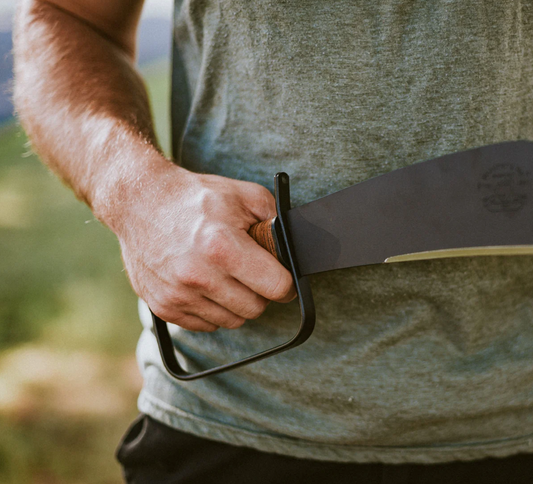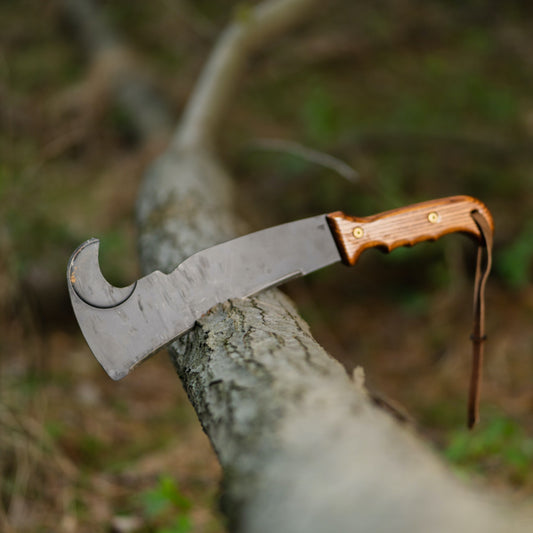Water is the most crucial resource in any survival situation. While you can go weeks without food, dehydration can become life-threatening in just a few days. If you're lost in the wild or facing an emergency, knowing how to find and collect water, even when you're not near a visible water source, can be the difference between life and death.
Let’s break down the best survival water collection techniques and how your Woodman’s Pal can assist in the process.
Recognizing Signs of Nearby Water
Even when a water source isn’t immediately visible, nature provides clues that water is close by.
Follow Animal Tracks
Animals need water just like humans do, so their behavior can give away hidden water sources. Birds often fly low in the early morning and evening near water sources, while larger animals, such as deer, follow distinct trails that often lead to water.
Keep an Eye on Insects
An abundance of mosquitoes or flies in a particular area is a strong indicator of water nearby. Insects tend to swarm around water, especially in low-lying areas.
Look for Lush Vegetation
Some plants thrive in wet environments. Willows, cottonwoods, and reeds are all good indicators that underground water is close. The greener and denser the foliage, the more likely you are to find water.
Collecting Water from Natural Sources
Even if there's no visible river or pond, water can still be gathered in the wild if you know where to look.
Morning Dew Collection
Grass, leaves, and rocks often accumulate dew overnight. You can collect moisture by tying an absorbent cloth around your legs and walking through tall grass at dawn. Wring out the water into a container and repeat until you have a sufficient amount.
Tree Tapping
Certain trees, such as birch and maple, contain drinkable sap or water. To collect water from a tree:
- Find a healthy tree with green leaves.
- Use a sharp blade, such as the Woodman’s Pal machete, to cut a small notch in the bark.
- Insert a small tube or leaf into the notch to direct the liquid into a container.
Digging for Groundwater
If you're in a dried-up riverbed or an area with dense vegetation, you can dig a small hole to access groundwater.
- Look for damp soil and start digging a shallow well.
- Wait for water to seep into the hole.
- If the water is murky, filter and purify it before drinking.
The Woodman’s Pal’s sturdy blade makes it easy to cut through roots and dig small wells in soft soil.
Creating a Solar Still for Water Collection
A solar still is a simple but effective way to collect water using evaporation.
How to Make a Solar Still
- Dig a hole about two feet wide and one foot deep.
- Place a container at the center to collect water.
- Cover the hole with a clear plastic sheet, securing the edges with rocks.
- Place a small stone in the middle of the plastic to create a slope toward the container.
- As the sun heats the ground, moisture will evaporate and condense on the plastic, dripping into your container.
Your Woodman’s Pal land-clearing tool can be used to clear an area for the still, cut branches to secure the plastic, and dig the pit efficiently.
Using Your Woodman’s Pal to Aid in Water Collection
A versatile tool like the Woodman’s Pal can be a lifesaver when trying to find water. Here’s how:
- Clearing Thick Vegetation: If you need to reach an area with better water prospects, the machete blade allows you to cut through dense undergrowth.
- Digging for Groundwater: The weighted blade helps chop through roots and loosen soil when digging for underground water sources.
- Cutting Tree Bark for Water: Easily notch trees to collect sap or water from certain species like birch and maple.
- Preparing Materials for a Solar Still: Cut branches and stakes to hold plastic in place, making water collection easier.
In a survival situation, having the right tool makes all the difference. The Woodman’s Pal isn’t just a cutting tool. It’s one of the best survival tools for finding water.
Purifying Water for Safe Drinking
Once you've collected water, it’s important to purify it to avoid illness from bacteria or parasites.
Filtering
Filtering water helps remove visible debris like dirt, leaves, insects, and other contaminants that may be floating around in your collected water. While filtering doesn’t kill harmful microorganisms, it’s a crucial first step before purifying the water using boiling or tablets.
You can use whatever materials you have on hand (a clean T-shirt, bandana, or coffee filter) to strain out sediment. Simply stretch the cloth over a clean container and pour the water slowly through it.
If you have a bit more time and resources, you can build a DIY survival water filter using a container (like an empty bottle or can) and layering the following materials:
- Fine sand to trap smaller particles.
- Charcoal from a fire to reduce odors and absorb impurities.
- Gravel or small stones to filter out larger debris.
Layer the materials from fine to coarse, with charcoal in the middle, and pour the water through slowly. Repeat the process if the water still looks cloudy. Once filtered, remember that this water is not yet safe to drink as it still needs to be purified to kill any pathogens.
Boiling
Boiling is hands-down one of the most reliable ways to purify water in a survival situation. It’s simple, effective, and doesn’t require any special gear beyond a heat source and a container that can handle it.
To purify water through boiling:
- Pour your filtered water into a metal pot, cup, or other fire-safe container.
- Bring the water to a rolling boil, where large bubbles are continuously breaking the surface.
- Boil for at least one full minute, or for three minutes if you’re at higher elevations where water boils at a lower temperature.
- Let the water cool before drinking or storing it in clean bottles for later use.
Boiling kills nearly all harmful microorganisms, including bacteria, viruses, and parasites. Just be sure to boil only clear, filtered water, as boiling muddy or contaminated water without filtering can concentrate harmful chemicals or heavy metals.
Chemical Treatment
Water purification tablets are a lightweight, reliable solution for disinfecting water in the field. Just drop the tablet into the container of collected water, wait the recommended time (usually around 30 minutes), and your water will be safe to drink.
They're small enough to carry in any survival kit, require no heat or special equipment, and are effective against most waterborne pathogens. For best results, always read the instructions on the packaging, as dosage and wait times can vary by brand.
Make Water One Less Thing to Worry About
Finding water in a survival situation requires awareness, resourcefulness, and the right tools. By reading the landscape, using simple collection methods, and purifying your water, you can stay hydrated even when no lakes or streams are in sight.
And when it comes to survival tools, the Woodman’s Pal is an indispensable companion that helps you clear paths, dig for water, and gather materials for survival techniques.
Want to make sure you’re prepared for any situation? Check out the Woodman’s Pal today and add it to your survival gear!


